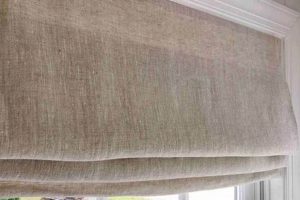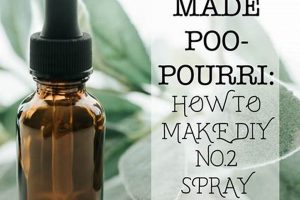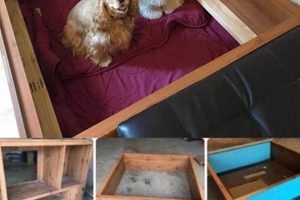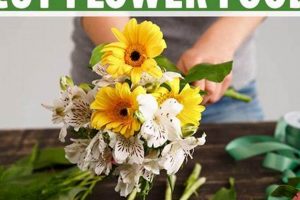Constructing playthings at home for rabbits presents an avenue for pet owners to provide enrichment and stimulation tailored to the specific needs and preferences of their animals. These homemade items can range from simple cardboard structures designed for chewing and exploration to more elaborate puzzle toys that encourage problem-solving skills. For instance, a toilet paper roll stuffed with hay becomes an instant, safe, and engaging activity for a rabbit.
Engaging in the practice of creating these enrichment items offers several advantages. It often results in cost savings compared to purchasing commercially manufactured alternatives. Further, it allows for the utilization of recycled materials, promoting environmental consciousness. Historically, owners have fashioned items for their pets using readily available resources, demonstrating ingenuity and a dedication to animal well-being. This approach ensures items are free of potentially harmful chemicals or small parts that could pose a choking hazard, prioritizing the animal’s safety.
The subsequent sections will delve into specific design considerations, appropriate materials for construction, and a variety of project ideas suitable for enhancing a rabbit’s environment. Focus will be placed on ensuring safety and encouraging natural behaviors through thoughtful design.
Guidelines for Crafting Play Items for Rabbits
This section provides crucial guidance for the responsible creation of play items, ensuring both stimulation and safety for domestic rabbits.
Tip 1: Material Selection is Paramount: Prioritize natural, untreated materials. Avoid plastics, chemically treated woods, or anything with paints or varnishes that could be toxic if ingested. Unbleached cardboard, untreated willow branches, and paper-based products are generally safe options.
Tip 2: Construction Safety: Ensure all components are securely fastened to prevent accidental ingestion or entanglement. Avoid using small parts, such as buttons or beads, that could present a choking hazard. Opt for non-toxic, rabbit-safe glue if adhesives are necessary.
Tip 3: Size and Accessibility: Design play items that are appropriately sized for the rabbit. Objects should be large enough to prevent accidental swallowing but small enough for the rabbit to manipulate and interact with comfortably. Ensure the rabbit can easily access and retreat from the play item.
Tip 4: Regular Inspection and Maintenance: Regularly inspect all play items for damage or wear. Discard any items that are broken, frayed, or show signs of deterioration. Damaged items can present a safety hazard.
Tip 5: Encourage Natural Behaviors: Design play items that encourage natural behaviors such as chewing, digging, and exploring. Tunnels, boxes filled with hay, and puzzle toys can provide valuable enrichment and stimulation.
Tip 6: Offer Variety: Rotate play items regularly to prevent boredom and maintain the rabbit’s interest. Introduce new textures, shapes, and challenges to keep the environment stimulating.
Tip 7: Monitor Interaction: Observe the rabbit’s interaction with the play items to identify any signs of stress or discomfort. Adjust the design or materials as needed to ensure the rabbit’s well-being.
Adherence to these guidelines ensures that play item construction contributes positively to the rabbit’s environment, providing mental and physical enrichment without compromising safety.
The final section will offer specific project ideas, incorporating these safety considerations and promoting engagement.
1. Safety first.
The principle of “Safety first” is paramount when engaging in the creation of homemade play items for rabbits. This necessitates a meticulous approach to material selection and construction methods, as rabbits frequently explore their environment through chewing and ingestion.
- Non-Toxic Materials
The selection of materials must prioritize the absence of toxic substances. Rabbits are prone to chewing, and any ingested material could pose a health risk. Materials like untreated wood, unbleached cardboard, and certain natural fiber ropes are generally considered safe. Conversely, materials containing paints, varnishes, or small detachable parts should be strictly avoided.
- Secure Construction
The method of assembly must ensure structural integrity to prevent the creation of hazards. Staples, glues (if used), and other fasteners should be non-toxic and securely embedded. Weak points or easily detached components represent potential choking or entanglement hazards for the rabbit.
- Size Considerations
The dimensions of the play item must be appropriate for the rabbit’s size and activity level. Small items can pose a choking risk, while excessively large or heavy items may cause injury during play. The item should allow the rabbit to interact comfortably without risk of entrapment or physical harm.
- Regular Inspection
Ongoing monitoring of the crafted item’s condition is essential. Regular inspection for damage, wear, or detachment of components enables the prompt removal of potentially hazardous toys. This proactive approach mitigates the risk of injury or ingestion of harmful materials.
Integrating “Safety first” into the design and maintenance of homemade rabbit play items directly correlates with the animal’s health and well-being. Careful material selection, robust construction, appropriate sizing, and diligent monitoring collectively contribute to a stimulating and secure environment, minimizing the potential for adverse health outcomes associated with play.
2. Material suitability.
The selection of appropriate materials is a fundamental determinant of the safety and efficacy of homemade play items for rabbits. The inherent connection between material suitability and the overall success of self-constructed rabbit toys arises from the animal’s natural chewing behavior and the potential for ingestion. Inappropriate materials can lead to toxic exposure, gastrointestinal obstruction, or physical injury, directly impacting the rabbit’s health and well-being. Therefore, material selection is not merely a peripheral consideration but a central tenet in the responsible creation of enrichment items.
Consider the use of untreated willow branches as a practical example. Willow wood is generally considered safe for rabbits, providing a natural chewing outlet that aids in dental health maintenance. Conversely, painted or treated wood introduces the risk of chemical ingestion. Similarly, unbleached cardboard offers a safe medium for rabbits to gnaw and shred, satisfying their instinctual behaviors. The intentional choice of these materials, based on their non-toxic properties and appropriate texture, exemplifies the practical application of material s
uitability in the context of self-made rabbit toys. Failure to adhere to these principles, such as substituting with plastic components, can result in severe health complications, necessitating veterinary intervention.
In summary, prioritizing material suitability is not only a responsible practice but a critical component in ensuring the safety and well-being of rabbits when engaging in homemade toy construction. The deliberate selection of non-toxic, digestible, and appropriately textured materials directly mitigates potential health risks and fosters a secure and enriching environment for the animal. This underscores the significance of informed material selection as an indispensable aspect of successful, self-constructed rabbit play items.
3. Durability of materials.
The long-term suitability and safety of homemade play items for rabbits hinge directly on the inherent durability of the chosen materials. This factor dictates the toy’s ability to withstand consistent use and the natural chewing behavior exhibited by rabbits, thereby influencing both its lifespan and the potential risk of fragmentation into hazardous pieces.
- Resistance to Chewing and Gnawing
Rabbits possess a natural inclination to chew, a behavior essential for maintaining dental health. Materials selected for homemade play items must exhibit resistance to degradation under sustained chewing pressure. For instance, untreated hardwood, while potentially suitable, should be selected carefully to avoid splintering. Cardboard, a common choice, should be of sufficient thickness to delay rapid disintegration. Lack of resistance increases the risk of the rabbit ingesting small, potentially harmful fragments.
- Withstanding Environmental Factors
Play items are often exposed to varying environmental conditions within a rabbit’s enclosure, including humidity and potential soiling. Durable materials maintain their structural integrity despite such exposure. Natural fibers, for example, should be chosen for their resistance to mold and decay. Materials that degrade quickly in humid environments necessitate more frequent replacement, increasing the overall cost and labor involved in maintaining enrichment.
- Longevity and Cost-Effectiveness
The lifespan of a play item directly correlates with its cost-effectiveness. Highly durable materials extend the period of use, reducing the frequency of replacement and the associated financial burden. While initially more expensive, materials with inherent durability offer long-term savings and minimize the time investment required for continuous toy construction.
- Safety Over Time
Material durability directly impacts safety over extended use. Weak or fragile materials are more likely to break down, creating small, sharp pieces that pose a choking hazard or risk of laceration. Regular inspection is necessary, but intrinsically durable materials inherently reduce the likelihood of such hazards arising in the first place, enhancing the overall safety profile of the homemade enrichment item.
The selection of durable materials is not merely a practical consideration but a critical safety measure in the construction of enrichment items for rabbits. These properties guarantee the long-term utility of the play object, optimize resource allocation, and, most importantly, minimize potential hazards to the animal’s health, underscoring its significance in promoting a safe and stimulating environment for rabbits.
4. Mental stimulation.
The creation of homemade enrichment devices directly addresses a crucial aspect of rabbit welfare: mental stimulation. The cognitive engagement provided by these devices combats boredom, a state that can manifest in destructive behaviors or apathy. The connection lies in the ability to tailor complexity to a rabbit’s individual capabilities and preferences, something often lacking in mass-produced items. For instance, a rabbit presented with a puzzle feeder constructed from cardboard tubes and hidden treats must actively problem-solve to access the reward, thus exercising its cognitive faculties. This active engagement promotes neurological health and reduces the likelihood of stress-related ailments.
The design process itself allows for a tiered approach to mental engagement. Initial designs may involve simple foraging tasks, such as scattering pellets within a hay-filled box, encouraging the rabbit to actively search for its food. As the animal demonstrates proficiency, the complexity can be increased by introducing barriers, compartments, or manipulating objects to reveal hidden rewards. For example, constructing a multi-layered maze from cardboard requires the rabbit to navigate a complex environment, remembering paths and adapting its strategy based on previous attempts. This gradual escalation ensures continuous cognitive challenge and prevents habituation, maintaining a high level of interest and engagement over time.
In summary, the integration of mental stimulation into play devices is not merely an ancillary benefit but a fundamental component of responsible rabbit care. The creation of these devices allows for precise control over the level of cognitive demand, ensuring that rabbits remain actively engaged and mentally challenged. This proactive approach mitigates the detrimental effects of boredom, promotes overall well-being, and strengthens the bond between animal and caretaker.
5. Behavioral relevance.
The concept of “behavioral relevance” is paramount in the design and implementation of enrichment items for domestic rabbits. Homemade play items, specifically, gain value through their capacity to stimulate species-typical behaviors, fostering psychological well-being and mitigating stress-related conditions.
- Foraging Simulation
A primary behavioral drive in rabbits is foraging. Appropriately designed items, such as hay-filled balls or treat-dispensing puzzles, encourage this behavior by requiring the animal to actively seek out food resources. The act of searching and manipulating the toy to obtain the reward mimics natural foraging patterns, providing mental stimulation and satisfying instinctual drives. Commercially available toys often lack this emphasis, instead offering readily accessible food that negates the foraging process.
- Chewing Provision
Rabbits possess continuously growing teeth, necessitating constant gnawing to prevent malocclusion. Providing suitable chewing materials, such as untreated wood blocks or cardboard structures, allows them to satisfy this physiological need in a safe and controlled manner. Constructing durable and appropriate chewing toys is critical, as rabbits will inevitably seek out alternative chewing substrates if adequate provisions are not available, potentially damaging furniture or ingesting harmful substances. Items crafted from rabbit-safe materials directly address this biological imperative.
- Digging Encouragement
Digging is another inherent behavior exhibited by rabbits. Constructing digging boxes filled with shredded paper or fabric allows them to expre
ss this instinct without damaging carpets or flooring. The provision of a designated digging area offers a controlled outlet for this behavior, reducing the likelihood of destructive digging in inappropriate locations. Furthermore, the texture and depth of the digging substrate can be varied to provide additional sensory enrichment. - Social Interaction Facilitation
While some rabbits are solitary, others benefit from social interaction. Toys designed for multiple rabbits to interact with simultaneously, such as tunnels or shared foraging puzzles, can promote social bonding and reduce competition for resources. It is important to observe the rabbits’ interactions to ensure that the toys facilitate positive social behavior rather than aggression. Thoughtful design can mitigate potential conflict and encourage cooperative play.
The effective application of “behavioral relevance” in play item design significantly enhances the quality of life for domestic rabbits. By providing opportunities to engage in species-typical behaviors, homemade toys contribute to psychological well-being, reduce stress, and prevent the development of behavioral problems. This approach underscores the importance of understanding rabbit ethology in the creation of enriching environments.
6. Appropriate size.
The principle of “Appropriate size” holds significant weight in the realm of DIY bunny toys, directly impacting the safety and engagement levels of rabbits. The dimensions of a play item must align with the rabbit’s physical capabilities and the intended purpose of the toy, creating a cause-and-effect relationship where incorrect sizing can lead to injury, disinterest, or inaccessibility. When constructing homemade toys, this consideration is paramount, as it influences both the rabbit’s ability to interact with the toy safely and the toy’s capacity to fulfill its intended enrichment function. For example, a tunnel that is too narrow can cause a rabbit to become stuck, leading to panic and potential injury, while a foraging toy with holes too small will frustrate the rabbit, negating its intended purpose of providing mental stimulation.
Furthermore, size is intrinsically linked to the material selection and construction techniques employed. Larger toys may require more robust materials to ensure durability and prevent breakage, while smaller items demand meticulous attention to detail to avoid small, detachable parts that pose a choking hazard. A critical practical application of this understanding is in the design of chew toys: an item that is too small can be swallowed whole, whereas an excessively large item may be cumbersome and deter the rabbit from engaging. Therefore, successful implementation of “Appropriate size” necessitates a comprehensive evaluation of the toy’s intended function, the rabbit’s physical characteristics, and the potential risks associated with the selected materials and construction methods.
In summary, the connection between “Appropriate size” and DIY bunny toys underscores a critical safety and engagement consideration. Disregard for proper sizing can result in hazards, diminished enrichment value, and ultimately, a negative impact on the rabbit’s well-being. Recognizing and addressing this component during the design and construction process ensures the creation of safe, stimulating, and functionally relevant play items. The challenges lie in accurately assessing the rabbit’s individual needs and translating that assessment into practical design decisions. These are important for positive results.
7. Environmental enrichment.
Environmental enrichment represents a critical component of responsible rabbit care, directly influencing their physical and psychological well-being. The strategic design and implementation of DIY bunny toys offer a tangible method of achieving this enrichment, addressing species-specific needs that may be inadequately met by commercially available products or standard housing provisions.
- Enhancing Physical Activity
DIY toys can be designed to promote physical activity, a vital aspect of rabbit health. Constructing tunnels, climbing structures, or treat-dispensing puzzles encourages movement and exploration, combating the sedentary lifestyle often associated with confinement. For instance, a simple cardboard box transformed into a multi-chambered maze prompts rabbits to engage in locomotor activity, mirroring their natural tendency to explore burrows and forage across varied terrains.
- Providing Cognitive Stimulation
Enrichment extends beyond physical activity to encompass cognitive engagement. DIY toys can challenge rabbits intellectually, preventing boredom and fostering problem-solving skills. Puzzle feeders, where rabbits must manipulate objects to access food, exemplify this approach. By varying the complexity of these puzzles, owners can continuously challenge their pets, preventing habituation and promoting sustained cognitive activity. This mimics the problem-solving required to locate food and evade predators in the wild.
- Facilitating Natural Behaviors
DIY bunny toys offer a means to facilitate natural behaviors, such as digging, chewing, and hiding. Providing digging boxes filled with shredded paper or fabric allows rabbits to express their digging instincts in a controlled environment, preventing destructive digging elsewhere. Similarly, offering untreated wood or cardboard provides suitable chewing outlets, maintaining dental health and redirecting chewing away from furniture or electrical cords. These toys, therefore, address fundamental behavioral needs that are often unmet in domestic settings.
- Promoting Sensory Exploration
Environmental enrichment involves stimulating a rabbit’s senses. DIY toys can incorporate a variety of textures, scents, and visual stimuli to enhance sensory experiences. For instance, incorporating different types of hay, herbs, or safe, rabbit-friendly scents into toys can stimulate olfactory exploration. Varying textures, such as smooth cardboard, rough wood, or soft fabric, provide tactile stimulation. These sensory-rich environments enhance the rabbit’s overall well-being and reduce the likelihood of stress-related behaviors.
These facets demonstrate the multifaceted role of DIY bunny toys in delivering comprehensive environmental enrichment. By thoughtfully designing toys that address physical, cognitive, behavioral, and sensory needs, owners can significantly enhance the quality of life for their rabbits, promoting both physical health and psychological well-being. The ability to tailor these enrichments to individual preferences and needs further underscores the value of DIY approaches in creating optimal environments for domestic rabbits.
Frequently Asked Questions
This section addresses common inquiries regarding the creation and utilization of homemade enrichment items for domestic rabbits, offering clarification on best practices and potential concerns.
Question 1: Are commercially available rabbit toys safer than items constructed at home?
Not necessarily. Both commercially produced and homemade play items present potential hazards. The safety hinges on material selection and construction quality. Commercially available toys may contain small parts, adhesives, or paints that are harmful if ingested. Homemade items
, if improperly constructed, may present choking hazards or utilize unsafe materials. Careful consideration of these factors is crucial regardless of the source.
Question 2: What materials are strictly prohibited for use in DIY rabbit toys?
Several materials pose significant risks to rabbits and should be avoided entirely. These include treated wood, as the chemicals can be toxic; small plastic components, due to the risk of ingestion and choking; and fabrics with loose weaves, which can lead to entanglement. Additionally, materials containing glues or adhesives not specifically labeled as non-toxic for animal use are unsuitable. Wire and metal components also present a potential hazard.
Question 3: How can the cleanliness of homemade rabbit toys be maintained?
Maintaining hygiene is essential to prevent the spread of disease. Toys constructed from washable materials, such as certain fabrics or plastics, should be cleaned regularly with a mild, rabbit-safe disinfectant. Cardboard items, due to their absorbent nature, are difficult to sanitize effectively and should be replaced frequently. Regular inspection and prompt removal of soiled or damaged items is also necessary to minimize bacterial contamination.
Question 4: Is it possible to create puzzle toys for rabbits using only household items?
Yes, numerous puzzle toys can be fashioned from readily available household materials. Cardboard boxes, toilet paper rolls, and paper bags can be repurposed into engaging enrichment items. The key lies in manipulating these items to create challenges that require the rabbit to problem-solve to access a reward, such as hidden treats or hay. Secure construction and the avoidance of potentially harmful fasteners are crucial.
Question 5: How frequently should rabbit toys be rotated to maintain interest and prevent boredom?
Toy rotation is a valuable strategy for maintaining a stimulating environment. As a general guideline, rotating toys on a weekly or bi-weekly basis can help prevent habituation and encourage ongoing engagement. The specific frequency may vary depending on the individual rabbit’s personality and interest level. Observation of the rabbit’s behavior can provide insights into the optimal rotation schedule.
Question 6: What are the signs that a DIY rabbit toy is unsafe and should be discarded?
Several indicators signal that a toy poses a potential hazard. These include the presence of sharp edges or splinters, loose or detachable parts, significant wear and tear, or evidence of chewing that has compromised the toy’s structural integrity. Any item exhibiting these signs should be removed immediately to prevent injury or ingestion of harmful materials.
Ultimately, responsible creation of homemade rabbit toys requires a comprehensive understanding of rabbit behavior, safe material selection, and diligent monitoring of the toy’s condition. Prioritizing these factors ensures the provision of enriching and safe play opportunities.
The subsequent section offers specific guidance on implementing a toy rotation system, maximizing enrichment and minimizing habituation.
DIY Bunny Toys
The preceding exploration of diy bunny toys has underscored the critical considerations involved in creating safe and enriching environments for domestic rabbits. Key areas of focus included material suitability, construction integrity, appropriate sizing, behavioral relevance, and the imperative for ongoing monitoring. Successfully implementing these principles directly contributes to the animal’s physical and psychological well-being, mitigating potential hazards and promoting natural behaviors.
The decision to engage in the creation of play items necessitates a commitment to prioritizing the animal’s safety and welfare above all else. Consistent application of the presented guidelines offers a tangible pathway toward fostering a stimulating and secure environment. Continued diligence and informed decision-making remain paramount in maximizing the benefits and minimizing the risks associated with DIY enrichment efforts. The responsibility lies with the caretaker to ensure these enrichments enhance, rather than compromise, the animal’s quality of life.







